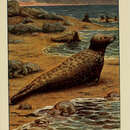en
names in breadcrumbs


Ringed Seals live primarily in the high Arctic and are heavily dependent on Arctic ice, almost never coming onto land. Warming spring temperatures and early ice breakup are causing nursing young to be prematurely separated from their mothers and to be exposed to both the elements and to predators (IUCN 2009).
Ringed Seal breeding is dependent on the availability of sufficient ice, at the correct time of year, in areas with sufficient food nearby. As the Arctic ice continues to melt earlier each year, more and more pups may be separated prematurely from their mothers. Both ice and snow must be stable enough in the spring season to allow successful completion of the six week lactation period. If the ice breaks up too soon, pups may be separated prematurely from their mothers, resulting in high pup mortality. Spring rains or warm spring temperatures can cause the roofs of lairs to prematurely collapse, leaving Ringed Seals unsheltered and exposed to predators. Insufficient snow at the beginning of the breeding season can have the same effect. Ringed Seals in some areas are already showing relatively long-term declines in reproductive rates and pup survival (IUCN 2009). Marked decreases in abundance are likely to have cascading effects in Arctic food webs. Ringed Seals are the most important species in the diet of Polar Bears.
As Arctic conditions warm, a greatly increased presence of humans in previously inaccessible areas is anticipated. Activities such as shipping, agriculture, and oil exploration are predicted to disturb and further degrade habitats and increased fishing in the area may reduce food availability (IUCN 2009).